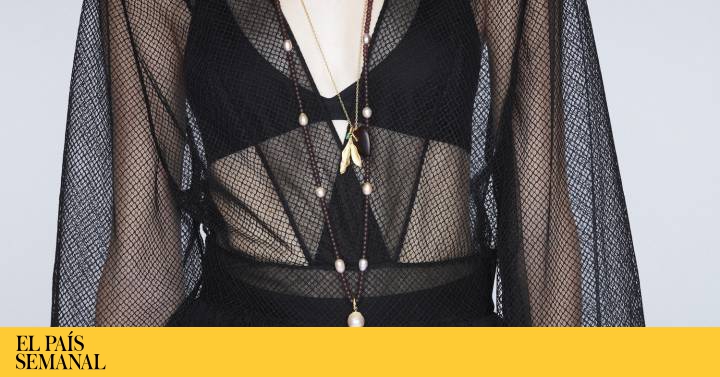The Sequenza 9.3 choir - made up of 12 women and directed by Catherine Simonpietri - breaks the silence and begins the last Dior fashion show to date: the first with an audience since confinement.
It is September 29 and we are in the Tuileries Gardens in Paris.
On the catwalk, 86 proposals for the spring-summer 2021 season, the one that no one knows yet if we will go through with or without a mask.
Behind, behind the scenes, a story that talks about how one of the most powerful brands in the sector faces this uncertain time, which, with a turnover of close to 50,000 million euros per year before the coronavirus, stands as one of the pillars of Louis Vuitton Moët Hennessy, the largest conglomerate of luxury companies in the world and owner of brands such as Givenchy, Fendi, Loewe or Dom Pérignon.
This structural weight makes any decision of the house a determining factor in the fashion industry.
That Dior parades in the old-fashioned way at Paris Fashion Week, where 80% of the firms showed their collections through online formats, launches a message of hope and continuity, supported by other historic French houses such as Hermès, Chanel and Louis Vuitton herself.
Although Maria Grazia Chiuri, creative director of the women's division, is aware that the crisis that the world is going through is radically transforming consumer behaviors and habits;
also the physical aptitudes, as he explains in a press release, where he also recognizes that the concept of contemporary fashion has been called into question.
A model from the Dior spring-summer 2021 collection.
MORGAN O'DONOVAN
“To be able to face this collection, I have had to interact with other women.
The goal was to find together an adequate response through fashion to this unprecedented uncertain time ”, says the creative director.
Among these women is Nanni Strada, a famous Italian textile designer who has collaborated with firms such as Ermenegildo Zegna, Max Mara or La Perla and who is proud to be the first to have produced plastic sandals in 1966. Her work, which always revolved around Around the feeling of well-being, it inspired Chiuri to reinterpret the classic Dior silhouette from comfort.
"I think that is what today's woman needs," she assures via video.
Maria Grazia Chiuri during the fitting of the Dior collection.
SOPHIE CARRE
That idea ties together his entire collection.
The Italian version of the coat
paletó
—a formal
garment—
in the form of ethnic tunics;
reinterprets the men's shirt - one of his favorites - into pieces that recall the iconic Dior shirt dresses, and proposes garments that flow over the body, favoring overlapping games and that reproduce the pattern of jackets created by the house specifically for the market Japanese in 1957.
Chiuri refers to writers, poets and intellectuals who believe in the privacy of their home.
From Virginia Woolf, wrapped in colored garments, to Susan Sontag, dressed in a white shirt.
Thus, it seeks to connect in an aspirational way with those millions of professionals who telework today, even though an Excel sheet is open in front of them and not exactly blank.
The tracksuit - at least today - is not part of the Dior vocabulary.
A moment from the Dior show.
ADRIEN DIRAND
Something much more artistic - the concept of
collage
- is fundamental in Maria Grazia Chiuri's speech.
First, referring to the combination of fabrics.
Because in her proposal for next spring, the Italian designer uses
shibori
and ikat, two textile techniques — the first from China;
the second, highly developed in India— in which the yarn is dyed and then the final motif is woven.
"I think that mixing elements from different cultures but that follow the same construction methodology is a way of making known what is beyond fashion," he explains.
The collage also stars in the staging of the collection.
Each season, Chiuri invites an artist to intervene on the catwalk.
In January 2020, for example, he collaborated with activist Judy Chicago, famous for her work
The Dinner Party
, a triangular table set up for 39 historical female figures that is part of the permanent collection of the Brooklyn Museum.
For the
Dior
show
, the American came up with huge hand-embroidered banners on which you could read phrases such as: "What if women ruled the world?"
or "Will mothers and fathers ever be the same?"
A detail from the Dior collection, SOPHIE CARRE
On this occasion, Chiuri chose Lucia Marcucci, a creator who analyzes through her work the influence of the media on the perception that women have of themselves and who signs the stained glass windows that framed the February parade.
In them, snippets from fashion magazines dialogue with works by Piero della Francesca, Georges de La Tour or Claude Monet.
As the models pass, voceri sound, Sicilian songs from the 19th century where words and sounds are mixed and which were sung by women when they lost a husband or a child. The liturgical atmosphere was undeniable. The dim light, the stained glass, the primitive chants. If the catwalk is a temple for Dior, fashion - continuing with the simile - constitutes a kind of religion or sect (depending on how you look at it). And if it has been called into question, as the brand recognizes, perhaps it is time for a council.

